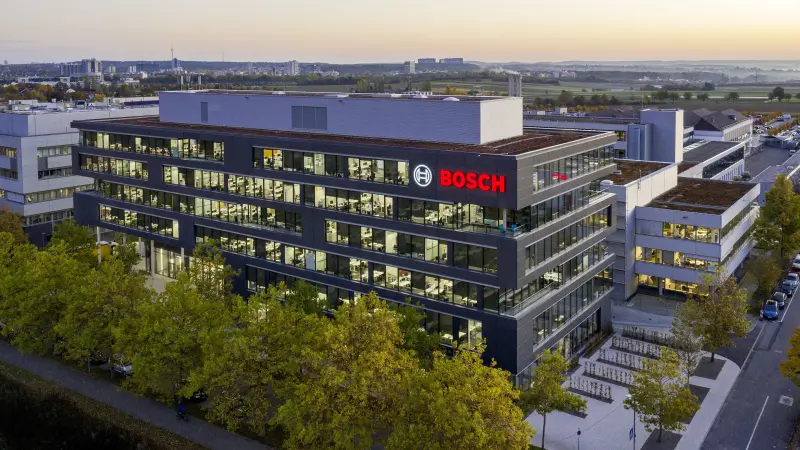Our sustainability approach
The topic of sustainability is firmly anchored in our values and has been an integral part of our corporate culture for decades. We are convinced that business and responsibility go hand in hand. That is why we are constantly driving forward our commitment to sustainability. Our aim is to have as little impact as possible on the environment. As a globally active company, we pursue a holistic approach to sustainability along the entire value chain and across all divisions.
Climate action across the entire value chain
Climate change is one of the biggest challenges facing humanity – stopping climate change is a task for the whole of society. As part of the Bosch Group, we are also committed at Bosch Power Tools to play a pioneering role in climate protection.
As early as 2020, the Bosch Group with its more than 450 locations worldwide has been carbon neutral overall (scope 1 & 2)*. Four levers were used to achieve carbon neutrality: increasing energy efficiency, generating our own energy from renewable sources (new clean power), purchasing electricity from renewable sources (green electricity), and – as the last resort – using carbon credits to offset residual CO₂ emissions. In 2024, residual emissions of around 531,300 metric tons of CO₂ were offset by carbon credits.
At the same time, we also want to reduce emissions produced outside Bosch’s direct sphere of influence (scope 3), for example at suppliers, in logistics, or when our products are used. Our aim is to reduce these upstream and downstream emissions by 30 percent in absolute terms by 2030, compared with the baseline year 2018 – irrespective of our company’s growth.
The Science Based Targets initiative (SBTi) endorsed our climate targets for the 1.5 degree pathway.** This means that Bosch has science-based climate targets for the entire value chain – from purchasing to the product use phase.

The three scopes at a glance
Scopes 1, 2 and 3 are used according to the Greenhouse Gas Protocol Corporate Accounting and Reporting Standard.
Scope 1
Scope 1 includes CO₂ emissions resulting from the combustion of fossil fuels such as petrol, diesel, heating oil, natural gas and coal, as well as all of the company's process gases.
Scope 2
Scope 2 includes indirect carbon emissions attributable to energy consumed in the form of electricity, district heating, and steam.
Scope 3
Scope 3 is divided into upstream and downstream emissions. Upstream emissions in the value chain primarily concern purchased goods and services as well as logistics. Downstream emissions are mainly caused by the product use.

We are working just as consistently to achieve our scope 3 target. The focus is primarily on the goods purchased, the materials and packaging used, product design and efforts to achieve a circular economy.
Certificates
ISO 9001
Bosch Power Tools is committed to the highest quality in every aspect – from development and production to customer service. Our ISO 9001 certification demonstrates our ongoing commitment to improving our processes and meeting our customers' requirements.
ISO 14001
Sustainability is an integral part of our corporate strategy. Our ISO 14001 certification documents our commitment to environmental protection and the continuous improvement of our environmental performance. We are committed to reducing our environmental impact and using resources responsibly.
ISO 45001
The safety of our employees is paramount at Bosch Power Tools. Our ISO 45001 certification demonstrates our comprehensive occupational health and safety management system and our commitment to safe and healthy working conditions. We are continuously striving to prevent accidents and occupational illnesses.
Since the end of 2023, the paper-based abrasives from Bosch Power Tools in Europe, USA, Canada and Mexico are FSC®-certified with the FSCTM Mix label. This relates to all paper-based abrasives manufactured after 09/2021, with the exception of the C410, C420, C422, C423 lines, which are not currently certified. FSC®-certification serves as a guarantee that the paper used in the manufacture of our abrasive papers is made of material from well-managed, FSC®-certified forests and other controlled sources. In this way, we are also reinforcing the sense of responsibility throughout our supply chain.
* Scopes 1, 2, and 3 are used here in accordance with the Greenhouse Gas Protocol Corporate Accounting and Reporting Standard. We have taken into account the effects of CO₂ and of other greenhouse gases, as well as climate-relevant substances, to the extent that these are of relevance for the analysis. To enable comparability between the climate impact of the various greenhouse gases and substances of relevance for the climate, emissions are presented in CO₂ equivalents. For ease of reading, we use the terms CO₂ and CO₂ equivalents synonymously.
** Robert Bosch GmbH’s entry in the SBTi’s target dashboard.















